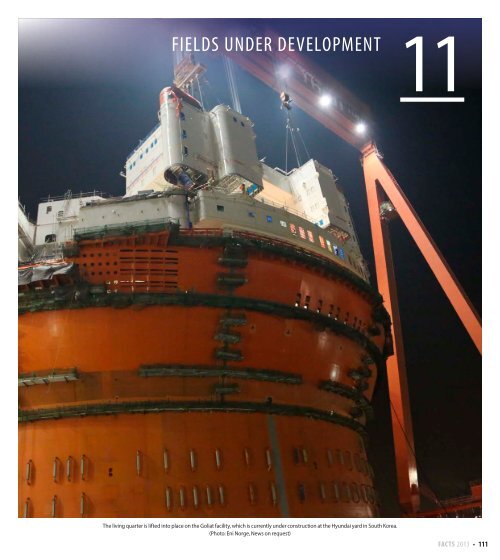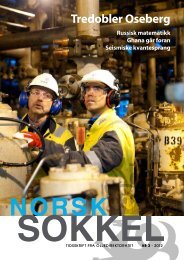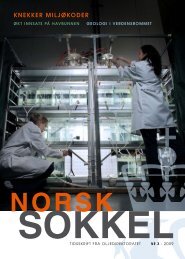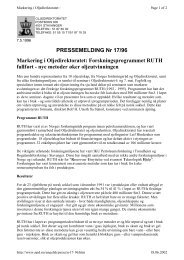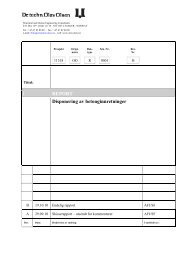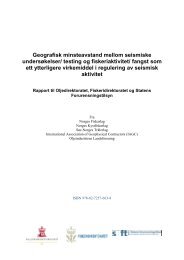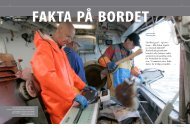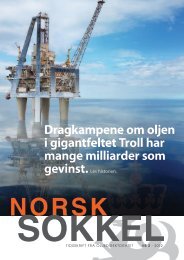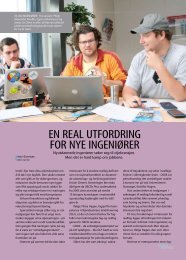You also want an ePaper? Increase the reach of your titles
YUMPU automatically turns print PDFs into web optimized ePapers that Google loves.
<strong>FIELDS</strong> <strong>UNDER</strong> <strong>DEVELOPMENT</strong>11The living quarter is lifted into place on the Goliat facility, which is currently under construction at the Hyundai yard in South Korea.(Photo: Eni Norge, News on request)FACTS 2013 • 111
-10°0°10°20°30°70°Jan MayenGoliatHammerfest70°TromsøBodø65°Skuld65°HymeTrondheimKnarrValemonFlorø60°Martin LingeBøylaGudrunEdvard GriegJetteSvalinBergenStavangerOslo60°BrynhildYme10° 20°Figure 11.1 Fields under development (Source: Norwegian Petroleum Directorate)112 • FACTS 2013
BrynhildBlocks and production licences Block 7/4 - production licence 148, awarded 1988.Block 7/7 - production licence 148, awarded 1988.Development approval 11.11.2011 by the King in Council Discovered 1992OperatorLundin Norway ASLicenseesLundin Norway AS 90.00 %Talisman Energy Norge AS 10.00 %Recoverable reservesOriginal3.6 million Sm³ oilExpected investment from 2012 5.0 billion 2012 valuesTotal investment as of 31.12.2011 0.2 billion nominal valuesDevelopment: Brynhild is located about 10 kilometres from the UK border,about 55 kilometres northwest of the Ula field and 38 kilometres fromthe UK Pierce field. The water depth in the area is about 80 metres. Thedevelopment concept is a subsea template and manifold, tied-in to theHæwene Brim FPSO located on the Pierce field in the UK. Water for injectionwill be supplied from Pierce.Reservoir: The reservoir lies at a depth of about 3 300 metres in Upper Jurassicsandstones in the Ula Formation. The reservoir contains under-saturated oilat reservoir conditions closely bordering high pressure – high temperature(HPHT) conditions.Recovery strategy: The Brynhild oil will be produced by pressure supportfrom water injection.Transport: The wellstream will be transported by pipeline to the HæweneBrim FPSO for metering and processing. The processed oil will be exportedby shuttle tankers to the market, while gas is re-injected into the Pierce field.Status: The PDO was approved in November 2011. Production is planned tostart in October 2013.BøylaBlocks and production licences Block 24/9 - production licence 340, awarded 2004.Development approval 26.10.2012 by the King in Council Discovered 2009OperatorMarathon Oil Norge ASConocoPhillips Skandinavia AS 20.00 %LicenseesLundin Norway AS 15.00 %Marathon Oil Norge AS 65.00 %Recoverable reservesOriginal3.4 million Sm³ oil0.3 billion Sm³ gasExpected investment from 2012 4.8 billion 2012 valuesTotal investment as of 31.12.2011 0.1 billion nominal valuesDevelopment: The oil discovery Bøyla is situated about 28 kilometres south ofthe Alvheim field. Water depth is about 120 metres. The development solutionfor Bøyla is a subsea template tied back to the Alvheim FPSO.Reservoir: The Bøyla reservoir is within the Hermod Sandstone Member, whichis a channelised sub-marine fan system of Late Paleocene to Early Eocene age,and lies at a depth of about 2 100 metres.Recovery strategy: Water injection is required for pressure support due tolimited connected aquifer volume. Gas lift will also be required to supportflow, once production wells start producing water.Transport: The oil and gas from Bøyla will be transported to Alvheim forprocessing and export.Status: The PDO was submitted in June 2012. Production is planned to startin October 2014.FACTS 2013 • 113
Edvard GriegBlocks and production licences Block 16/1 - production licence 338, awarded 2004.Development approval 11.06.2012 by the Storting Discovered 2007OperatorLundin Norway ASLundin Norway AS 50.00 %LicenseesOMV (Norge) AS 20.00 %Wintershall Norge AS 30.00 %Recoverable reservesOriginal26.2 million Sm³ oil1.8 billion Sm³ gas0.6 million tonnes NGLExpected investment from 2012 21.7 billion 2012 valuesDevelopment: Edvard Grieg is located about 35 kilometres south of Graneand Balder. The water depth is about 110 metres. The development comprisesa PdQ jacket solution using a separate jack-up for drilling and completion. ThePdQ platform will have sufficient spare well slots for possible additional wells,together with the possible development of nearby discoveries and prospects.Reservoir: The reservoir contains oil at a depth of 1 900 – 1 940 metres. Thereservoir consists of Upper Triassic to Lower Cretaceous alluvial, aeolian andshallow marine conglomerates and sandstones. Oil is also proven in theunderlying basement.Recovery strategy: Edvard Grieg will be produced by pressure support fromwater injection.Transport: The oil will be exported by pipeline to the Grane Oil Pipeline,which is connected to the Sture terminal. The gas is planned to be exportedin a separate pipeline to the Scottish Area Gas Evacuation (SAGE) System.Status: The platform is under construction. Production is planned to startin late 2015.GoliatBlocks and production licences Block 7122/10 - production licence 229, awarded 1997.Block 7122/11 - production licence 229 B, awarded 2007.Block 7122/7 - production licence 229, awarded 1997.Block 7122/8 - production licence 229, awarded 1997.Development approval 18.06.2009 by the Storting Discovered 2000OperatorEni Norge ASLicenseesEni Norge AS 65.00 %Statoil Petroleum AS 35.00 %OriginalRecoverable reserves30.2 million Sm³ oil7.3 billion Sm³ gas0.3 million tonnes NGLExpected investment from 2012 26.7 billion 2012 valuesTotal investment as of 31.12.2011 10.2 billion nominal valuesDevelopment: Goliat is an oilfield located about 50 kilometres southeast ofthe Snøhvit field in the Barents Sea. The water depth in the area is 360 – 420metres. Goliat will be developed with a circular FPSO (Sevan 1000) includingeight subsea templates with a total of 32 well slots. The subsea templateswill be tied back to the FPSO with an integrated storage and loading system.Reservoir: The Goliat reservoirs contain oil and thin gas caps in Triassicsandstones of the Kapp Toscana Group (Realgrunnen subgroup) and theKobbe Formation. The reservoirs lie at a depth of 1 100 – 1 800 metres in acomplex and segmented structure.Recovery strategy: Goliat will be produced using water injection as pressuresupport. Associated gas will be re-injected until a possible export solution forgas through the Snøhvit pipeline to Melkøya is in place.Transport: The oil will be offloaded to shuttle tankers and transported tothe market.Status: Production is planned to start late in 2014.114 • FACTS 2013
GudrunBlocks and production licences Block 15/3 - production licence 025, awarded 1969.Development approval 16.06.2010 by the Storting Discovered 1975OperatorStatoil Petroleum ASLicenseesGDF SUEZ E&P Norge AS 25.00 %Statoil Petroleum AS 75.00 %OriginalRecoverable reserves11.7 million Sm³ oil6.4 billion Sm³ gas1.3 million tonnes NGLExpected investment from 2012 12.9 billion 2012 valuesTotal investment as of 31.12.2011 5.9 billion nominal valuesDevelopment: Gudrun is located 50 kilometres north of Sleipner. The waterdepth is approximately 110 metres. Gudrun is being developed with a fixedfacility with a steel jacket and first-stage processing, tied back to Sleipner Athrough two dedicated pipelines; one for oil and one for rich gas.Reservoir: The reservoirs contain oil and gas in Upper Jurassic sandstones inthe Draupne Formation and gas in the Middle Jurassic Hugin Formation. Thereservoirs lie at a depth of 4 000 - 4 760 metres.Recovery strategy: Gudrun will be produced by natural pressure depletion.Transport: Oil and gas will be transported to the Sleipner A facility for furtherprocessing and export.Status: Production is planned to start in 2014.HymeBlocks and production licences Block 6407/8 - production licence 348, awarded 2004.Development approval 24.06.2011 by the King in Council Discovered 2009OperatorStatoil Petroleum ASCore Energy AS 17.50 %E.ON E&P Norge AS 17.50 %LicenseesFaroe Petroleum Norge AS 7.50 %GDF SUEZ E&P Norge AS 20.00 %Statoil Petroleum AS 35.00 %VNG Norge AS 2.50 %OriginalRecoverable reserves3.2 million Sm³ oil0.5 billion Sm³ gas0.2 million tonnes NGLExpected investment from 2012 3.9 billion 2012 valuesTotal investment as of 31.12.2011 0.9 billion nominal valuesDevelopment: Hyme is located about 19 kilometres northeast of the Njordfield and about 10 kilometres west of Draugen. The water depth in the area isabout 260 metres. Hyme will be developed with a standard subsea templatewith four well slots. Hyme is connected to the Njord facility with a productionpipeline, a water injection pipeline, and a pipeline for gas lift. The developmentplan includes one production well and one water injection well.Reservoir: The reservoir contains oil and gas in the Lower Jurassic Tilje Formation.The reservoir is located at a depth of about 2 150 metres. The qualityof the reservoir is good.Recovery strategy: The drainage strategy is a two-branched well on the topof the structure and water injection for pressure support.Transport: Oil and gas will be transported via the Njord facility.Status: The field came on stream in February 2013.FACTS 2013 • 115
JetteBlocks and production licences Block 25/7 - production licence 504, awarded 2009.Block 25/8 - production licence 027 D, awarded 2007.Block 25/8 - production licence 169 C, awarded 2009.Development approval 17.02.2012 by the King in Council Discovered 2009OperatorDet norske oljeselskap ASALicenseesDet norske oljeselskap ASA 70.00 %Petoro AS 30.00 %OriginalRecoverable reserves1.5 million Sm³ oil0.1 billion Sm³ gasExpected investment from 2012 3.9 billion 2012 valuesTotal investment as of 31.12.2011 0.3 billion nominal valuesDevelopment: Jette is located about six kilometres south of the Jotun Field.Water depth is about 127 metres. Jette will be developed with a subsea templatetied to the Jotun A facility.Reservoir: The reservoir is in the Heimdal Formation, which is a sub-marinefan system of the Late Paleocene age and lies at a depth of approximately2 200 metres.Recovery strategy: Jette will be produced with natural pressure supportfrom aquifer.Transport: The wellstream will go to Jotun A and further to Jotun B for processingand loading.Status: The PDO was approved in February 2012. Production is planned tostart in the second quarter of 2013.KnarrBlocks and production licences Block 34/3 - production licence 373 S, awarded 2006.Development approval 09.06.2011 by the Storting Discovered 2008OperatorBG Norge ASBG Norge AS 45.00 %LicenseesIdemitsu Petroleum Norge AS 25.00 %RWE Dea Norge AS 10.00 %Wintershall Norge AS 20.00 %OriginalRecoverable reserves11.9 million Sm³ oil0.3 billion Sm³ gas0.8 million tonnes NGLExpected investment from 2012 10.0 billion 2012 valuesTotal investment as of 31.12.2011 0.5 billion nominal valuesDevelopment: Knarr is located approximately 50 kilometres northeast ofSnorre. The water depth is 410 metres. Knarr is being developed with anFPSO and two subsea templates for production and injection, connected toa subsea manifold.Reservoir: The reservoir lies at a depth of about 3 800 metres and containsoil in Lower Jurassic sandstones in the Cook Formation.Recovery strategy: The production strategy will include pressure maintenanceby water injection.Transport: Oil will be offloaded from the Knarr FPSO to tankers, and the gaswill be routed in a new gas pipeline to the Far North Liquids and AssociatedGas System (FLAGS) and exported to St Fergus in the UK.Status: The FPSO and subsea facilities are under construction. Drilling ofdevelopment wells will start in summer 2013 and production is planned tostart in May 2014.116 • FACTS 2013
Martin LingeBlocks and production licences Block 29/6 - production licence 043, awarded 1976.Block 29/6 - production licence 043 BS, awarded 2006.Block 29/9 - production licence 040, awarded 1975.Block 30/4 - production licence 043, awarded 1976.Block 30/4 - production licence 043 BS, awarded 2006.Block 30/7 - production licence 040, awarded 1975.Development approval 11.06.2012 by the Storting Discovered 1978OperatorTotal E&P Norge ASPetoro AS 30.00 %LicenseesStatoil Petroleum AS 19.00 %Total E&P Norge AS 51.00 %Recoverable reservesOriginal6.0 million Sm³ oil19.7 billion Sm³ gas0.7 million tonnes NGL3.0 million Sm³ condensateExpected investment from 2012 23.9 billion 2012 valuesTotal investment as of 31.12.2011 0.4 billion nominal valuesDevelopment: Martin Linge is located near the border to the British sector,about 42 kilometres west of Oseberg. The water depth in the area is 100 – 120metres. Martin Linge will be developed with a fully integrated fixed productionplatform with an FSO for oil and condensate storage. The wells will be drilled bya mobile jack-up rig. The installation will be supplied with power from shore.Reservoir: The main reservoir is structurally complex, and contains gas andcondensate at high temperatures and pressure. There are three reservoirsin Middle Jurassic sandstones in the Brent Group at a depth of 3 700 – 4 400metres. In addition, the field contains oil in the Frigg Formation of Eocene ageat approximately 1 750 metres. The Frigg Formation has good reservoir quality.Recovery strategy: The gas reservoir will be produced by pressure depletion,whereas the oil production from the Eocene reservoir will be supported bynatural aquifer drive and gas lift. Produced water will be re-injected into adisposal reservoir.Transport: Rich gas will be transported through a pipeline to the FUKA gastransport system on the UK sector, and oil and condensate will be exportedvia tankers from the FSO.SkuldBlocks and production licences Block 6608/10 - production licence 128, awarded 1986.Development approval 20.01.2012 by the King in Council Discovered 2008OperatorStatoil Petroleum ASEni Norge AS 11.50 %LicenseesPetoro AS 24.55 %Statoil Petroleum AS 63.95 %Recoverable reservesOriginal13.4 million Sm³ oil0.6 billion Sm³ gas0.1 million tonnes NGLExpected investment from 2012 8.8 billion 2012 valuesTotal investment as of 31.12.2011 1.4 billion nominal valuesDevelopment: Skuld is located in the Norwegian Sea, north of the NorneField, at a water depth of about 340 metres. The field consists of the two oildeposits, 6608/10-12 Dompap and 6608/10-14 S Fossekall, which are located26 and 16 kilometres, respectively, north of the Norne vessel. Skuld is beingdeveloped with subsea templates tied back to the Norne FPSO.Reservoir: The reservoirs consist of Lower to Middle Jurassic sandstonesin the Åre, Tofte and Ile Formations at a depth of 2 400–2 600 metres. Thereservoirs contain oil.Recovery strategy: Skuld will be recovered with pressure support by waterinjection. In addition, some of the wells will be supplied with gas lift to be ableto produce at low reservoir pressure and high water cut.Transport: The wellstream will be processed on the Norne vessel, and the oilwill be buoy-loaded together with the oil from the Norne field. The gas willbe transported by pipeline from the Norne vessel to Åsgard, then further viaÅsgard Transport System to Kårstø.Status: The PDO was approved in January 2012. Drilling of the developmentwells started in March 2012, and production is planned to start in the firsthalf of 2013.Status: Production is planned to start by the end of 2016.FACTS 2013 • 117
SvalinBlocks and production licences Block 25/11 - production licence 169, awarded 1991.Development approval 23.11.2012 by the King in Council Discovered 1992OperatorStatoil Petroleum ASExxonMobil Exploration & Production Norway AS 13.00 %LicenseesPetoro AS 30.00 %Statoil Petroleum AS 57.00 %Recoverable reservesOriginal12.1 million Sm³ oilExpected investment from 2012 4.2 billion 2012 valuesDevelopment: Svalin is located 8 kilometres southwest of the Grane field. Thewater depth in the area is approximately 120 metres. Svalin will be developedby a multilateral well drilled from the Grane platform, and with a subseafacility tied in to Grane.Reservoir: There is oil and associated gas in Paleocene to Lower Eocenesandstones in the Heimdal and Balder Formations at a depth of approximately1 750 metres. The sandstones are deposited as sub-marine fans.Recovery strategy: Svalin will be recovered by pressure depletion.Transport: The wellstream will be processed on Grane and transported bypipeline to the Sture terminal for storage and export.Status: The PDO was approved in 2012. Production from Svalin is planned tostart in two phases, in November 2013 and in June 2014.ValemonBlocks and production licences Block 30/1 - production licence 050 C, awarded 1999.Block 34/10 - production licence 050, awarded 1978.Block 34/10 - production licence 050 B, awarded 1995.Block 34/10 - production licence 050 D, awarded 2007.Block 34/11 - production licence 193 B, awarded 2009.Block 34/11 - production licence 193 D, awarded 2011.Development approval 09.06.2011 by the Storting Discovered 1985OperatorStatoil Petroleum ASCentrica Resources (Norge) AS 13.00 %LicenseesEnterprise Oil Norge AS 3.23 %Petoro AS 30.00 %Statoil Petroleum AS 53.78 %OriginalRecoverable reserves4.9 million Sm³ oil26.1 billion Sm³ gas1.3 million tonnes NGLExpected investment from 2012 16.8 billion 2012 valuesTotal investment as of 31.12.2011 1.5 billion nominal valuesDevelopment: Valemon is located in blocks 34/11 and 34/10, just west ofthe Kvitebjørn field. The water depth is 135 metres. Several appraisal wellshave been drilled on the discovery. The development concept is a fixed steelproduction platform with a simplified separation process. The platform willbe remotely controlled from the Kvitebjørn field or from shore.Reservoir: The deposit has a complex structure with several faults. Thereservoirs consist of Middle Jurassic sandstones in the Brent Group and LowerJurassic sandstones in the Cook Formation. The reservoirs lie at a depth ofapproximately 4 000 metres, with high pressure and temperature.Recovery strategy: Valemon will be produced by pressure depletion.Transport: The condensate will be transported by pipeline to Kvitebjørn,and via the Kvitebjørn oil pipeline to Mongstad. The rich gas is planned to beexported in the Huldra pipeline to Heimdal for further export to the UnitedKingdom or the Continent.Status: The platform is under construction. Drilling of wells started in 2012and production start is scheduled for October 2014.118 • FACTS 2013


